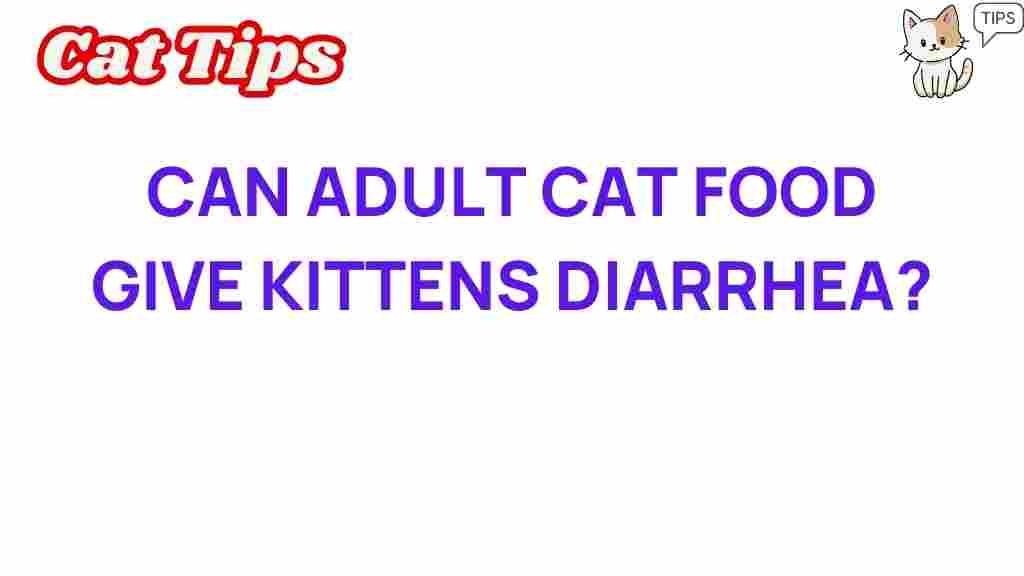The Hidden Dangers of Adult Cat Food for Kittens: What You Need to Know
As a cat owner, you want the best for your furry friend, especially if you’re raising a kitten. However, many pet owners might not realize that feeding adult cat food to kittens can lead to significant health issues. In this article, we will explore the hidden dangers of adult cat food and explain why it’s essential to choose the right diet tailored to your kitten’s needs.
Understanding Kitten Nutritional Needs
Kittens have specific dietary requirements that differ significantly from those of adult cats. Understanding these needs is crucial for their healthy development.
- Growth and Development: Kittens experience rapid growth and require higher levels of protein and fat.
- Caloric Needs: Kittens need more calories per pound of body weight than adult cats to support their energy levels.
- Vitamins and Minerals: Key nutrients such as calcium and phosphorus are vital for bone development.
By feeding them adult cat food, you risk depriving them of these essential nutrients, leading to potential health problems.
The Risks of Adult Cat Food for Kittens
Feeding your kitten adult cat food can pose several hidden dangers. Let’s break down some of the most critical issues:
1. Nutritional Imbalance
Adult cat food is formulated for the nutritional needs of fully grown cats. It typically contains less protein, fat, and essential vitamins than what a kitten needs. This imbalance can lead to:
- Stunted Growth: Insufficient protein can hinder your kitten’s growth and overall development.
- Bone Problems: Low levels of calcium and phosphorus can lead to skeletal issues.
- Immune System Weakness: A lack of vital nutrients can weaken a kitten’s immune system, making them more susceptible to diseases.
2. Digestive Issues
Kittens have sensitive digestive systems. Adult cat food may be too rich or heavy for them, leading to:
- Diarrhea: An abrupt change in diet can upset a kitten’s stomach.
- Vomiting: Kittens may struggle to digest adult food properly, resulting in vomiting.
- Obesity: Overeating adult food can lead to unhealthy weight gain.
3. Behavioral Changes
Diet can also influence a kitten’s behavior. Inappropriate food might lead to:
- Hyperactivity: High levels of certain ingredients in adult food can cause hyperactive behavior.
- Lethargy: Conversely, low energy levels might result from inadequate nutrition.
How to Choose the Right Food for Your Kitten
Choosing the right food is essential for ensuring your kitten’s health and happiness. Here’s a step-by-step guide to help you select the best options:
Step 1: Look for Kitten-Specific Formulas
Always opt for cat food labeled specifically for kittens. These formulas are designed to meet their unique nutritional needs.
Step 2: Check the Ingredients
Quality ingredients are crucial. Look for:
- High-Quality Proteins: Chicken, turkey, or fish should be the first ingredient.
- Healthy Fats: Omega fatty acids are important for a healthy coat and skin.
- Essential Vitamins and Minerals: Calcium and phosphorus should be included in the right ratios.
Step 3: Consult Your Veterinarian
Your veterinarian can provide personalized recommendations based on your kitten’s age, weight, and overall health. It’s always best to seek professional advice.
Feeding Tips for Kittens
Once you’ve chosen the right food, here are some feeding tips to ensure your kitten thrives:
- Establish a Feeding Schedule: Kittens typically need to eat multiple times a day. Aim for three to four meals daily.
- Provide Fresh Water: Ensure your kitten has access to fresh water at all times.
- Monitor Their Weight: Regularly check your kitten’s weight to ensure they’re growing at a healthy rate.
Troubleshooting Common Issues
If you notice any problems while transitioning your kitten to the right food, here are some troubleshooting tips:
1. If Your Kitten Refuses to Eat
Some kittens may be picky eaters. Try the following:
- Warm the Food: Warming up the food can enhance its aroma.
- Mix with Wet Food: If you’re using dry food, mix in a bit of wet food to entice them.
- Try Different Flavors: Experiment with different flavors or brands until you find one they like.
2. If You Notice Digestive Issues
Should your kitten experience digestive upset, consider these steps:
- Gradual Transition: If switching foods, do it gradually over a week to minimize digestive disruptions.
- Consult Your Vet: If issues persist, seek veterinary advice as it may indicate a more serious problem.
3. If Your Kitten Shows Signs of Allergies
Common signs of food allergies include itching, redness, or gastrointestinal upset. If you suspect allergies:
- Switch to Hypoallergenic Food: Consider trying a hypoallergenic formula.
- Keep a Food Diary: Track what your kitten eats to identify potential triggers.
- Seek Veterinary Help: Consult with your veterinarian for further evaluation.
The Importance of Proper Nutrition
Proper nutrition sets the foundation for a kitten’s health, growth, and behavior. Choosing the right food is not just about preventing immediate health issues; it’s also about ensuring long-term well-being.
Feeding adult cat food to kittens can lead to hidden dangers that affect their growth, development, and overall health. By understanding the specific needs of your kitten and choosing the right food, you can help them thrive.
Conclusion
In conclusion, while adult cat food may seem convenient, it poses hidden dangers to your growing kitten. From nutritional imbalances to digestive issues, the risks far outweigh the benefits. Always opt for kitten-specific food to provide the right balance of nutrients for healthy growth and development.
Remember to consult with your veterinarian for personalized advice and monitoring. For more information on feline nutrition, you can visit this resource or check out our other articles here.
By investing time and care into your kitten’s diet now, you will be setting the stage for a happy, healthy, and vibrant adult cat in the future.
This article is in the category Nutrition and created by CatTips Team
